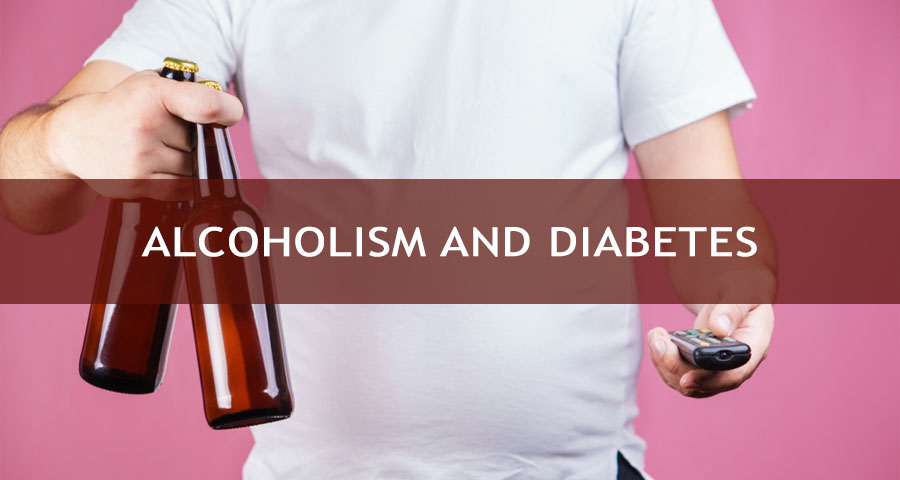
Diabetes mellitus is a growing public health concern affecting Americans regardless of place, age group or gender. As of April 2023, around 38 million people in the U.S. live with diabetes, with 90-95% of these cases suffering type 2 diabetes.
Several factors can raise the risk of developing diabetes, including obesity, a sedentary lifestyle and a family history of diabetes. Now, alcohol consumption has been added as a contributing element. Given the widespread availability of alcohol, understanding alcohol’s role in diabetes progression and related complications is essential.
Can drinking cause diabetes? Keep reading to find the answer, the risks of alcohol and diabetes and tips for responsible consumption.
Table Of Contents:
What Is Diabetes?
Diabetes is a lifelong chronic health condition characterized by high blood glucose (sugar) levels.
Glucose levels are regulated by insulin, a hormone produced by the pancreas that facilitates the conversion of glucose in the bloodstream to cellular energy. In diabetes, the body either does not produce enough insulin or cannot effectively use the insulin it produces, leading to high blood sugar levels.
There are primarily two main types of diabetes:
- Type 1 diabetes: Autoimmune condition requiring lifelong insulin due to minimal or no insulin production
- Type 2 diabetes: More common and linked to insulin resistance or insufficient production
In addition to type 1 (common in late childhood or adolescence) and type 2 diabetes (common in adults over 40), there are other forms of diabetes, including gestational diabetes. Symptoms may include frequent thirst and urination, unexplained weight loss, blurry vision, fatigue, slow-healing sores and frequent infections.
Can Drinking Alcohol Cause Diabetes?
Alcohol doesn’t cause diabetes by itself but rather activates a cascade response that disrupts glucose homeostasis, potentially causing the development of insulin resistance. This disruption is linked to chronic alcohol consumption, particularly in type 2 diabetes mellitus (T2DM).
Three main pathways are known to lead to the link between diabetes and alcohol abuse:
1. Insulin Sensitivity
Insulin sensitivity, or insulin resistance, refers to how effectively the body’s cells respond to insulin.
When someone consumes alcohol heavily over a prolonged period, it can lead to a decrease in insulin sensitivity, becoming less efficient at using insulin to regulate blood sugar levels, resulting in high blood sugar levels over time. Insulin resistance does not immediately lead to diabetes. This condition is commonly referred to as “prediabetes.”
Yet, if alcohol and prediabetes are left untreated, the person will likely develop type 2 diabetes. Insulin resistance is partly influenced by genetics and lifestyle factors such as obesity, lack of exercise, and smoking may worsen inherited predispositions.
2. Chronic Pancreatitis
Chronic pancreatitis is a progressive and irreversible disorder marked by inflammation of the pancreas, frequently resulting from prolonged alcohol abuse. In adults, alcoholism is responsible for 70% of cases.
The pancreas is crucial in regulating blood sugar levels by producing insulin. When the pancreas becomes inflamed, its ability to produce insulin can be compromised. This condition may progress to insulin deficiency, increasing the risk of developing type 2 diabetes.
3. Weight Gain/Obesity
Alcohol represents an important source of energy since most alcoholic beverages are often high in sugars and carbohydrates.
Alcohol inhibits your body’s ability to burn fat, boosting appetite and triggering cravings for a high-calorie diet. This, combined with alcohol’s high-calorie content, can create an energy imbalance, leading to weight gain and a higher risk of alcohol-induced diabetes.
Can A Diabetic Drink Alcohol?
There isn’t a cut-through answer to this question since it depends on various factors, including the patient’s overall health status, medication regimen, and how much alcohol they consume.
The American Diabetes Association (ADA) recommends that diabetics only drink alcohol if the condition is under control and the healthcare provider agrees. Nevertheless, alcohol intake must be moderate, defined as one drink per day for women and up to two per day for men.
If you are wondering how much alcohol a diabetic can drink, follow the below guidelines for reference on diabetes alcohol:
| Type of Beverage | Size of Beverage | Alcohol Percentage | Approximate Calories |
|---|---|---|---|
| Regular Beer | 12 ounces (about 355 milliliters) | 5% | 150-200 calories |
| Light Beer | 12 ounces (about 355 milliliters) | 4% | 90-110 calories |
| Wine (red or white) | 5 ounces (about 148 milliliters) | 12% | 120-130 calories |
| Distilled Spirits | 1.5 ounces (about 44 milliliters) | 40% | 90-100 calories |

Source: National Institute on Alcohol Abuse and Alcoholism (NIAAA)
These examples represent one standard drink in the U.S. containing approximately 14 grams of pure alcohol. The calorie counts can vary depending on the brand, specific ingredients in prepared cocktails, and alcohol content.
Risks of Diabetes and Alcohol Drinking
The impact of alcohol and diabetes varies greatly based on whether it is consumed on a full stomach, causing higher blood sugar levels, or on an empty stomach after not eating for several hours, resulting in lower blood sugar levels.
Alcohol consumption under specific conditions in both types of diabetic patients may cause the following risks:
- Heavy drinking on a full stomach can cause high blood sugar levels (hyperglycemia)
- Heavy drinking while fasting can induce severe hypoglycemia in diabetics
- Alcoholic beverages are often high in calories, contributing to weight gain and insulin resistance
- Chronic drinking harms the liver, causes kidney and cardiovascular disease, nerve damage, eye problems
- Alcohol can interact with diabetes medications, affecting their effectiveness
Is it safe to drink alcohol if you have diabetes? A study suggests people with either type 1 or type 2 diabetes don’t experience clinically significant changes in blood sugar levels after single episodes of alcohol consumption. One drink can be considered safe if the condition is controlled.
Alcoholism and Diabetes
Treating individuals with dependence on alcohol and diabetes presents various challenges. These patients may lack the motivation to alter their lifestyle habits and face a higher risk of hypoglycemia.
If alcohol dependence is co-concurrently present with diabetes, make sure to:
- Regularly monitor blood sugar levels and liver function to assess the impact of alcohol
- Coordinate between diabetes and addiction specialists to adapt treatment plans
- Adjust diabetes medications as needed to maintain blood sugar control
- Seek guidance on healthy eating, low-calorie diet
- Be open to strategies and support to reduce your alcohol intake (therapy, detox, medications)
- Address underlying factors such as stress management and coping skills with therapy
- Add regular physical activity, adequate sleep, and proper hydration
- Build a strong support network for both alcohol and diabetes
- Develop tailored strategies to identify triggers and maintain sobriety
Can Alcoholism Cause Diabetes? − Final Considerations
Diabetic patients may benefit from alcohol’s favorable effects, including improved insulin sensitivity and cardiovascular protection. However, heavy drinking will cause not only metabolic disruption but also cardiovascular diseases.
Both diabetic and non-diabetic individuals should be mindful of alcohol and calorie intake to prevent complications or disease development. Alcohol-induced diabetes can be avoided through mindful lifestyle practices and healthy eating. If alcohol dependence or diabetes is suspected, don’t hesitate to call a healthcare professional.
People Also Ask
Does alcohol cause diabetes?
No, but heavy drinking can increase your risk of type 2 diabetes by affecting insulin sensitivity and contributing to weight gain and chronic pancreatitis.
Can diabetics drink vodka?
Individuals with diabetes should be mindful of vodka containing 40% alcohol and approximately 90-100 calories per 1.5 ounces. Monitoring blood sugar levels is crucial for responsible alcohol consumption.
Can quitting alcohol reverse diabetes?
Quitting alcohol generally won’t reverse diabetes, but it can significantly improve blood sugar control, making it easier to manage the condition.
Hope Without Commitment
Find the best treatment options. Call our free and confidential helpline
Most private insurances accepted
Find Drug Rehabilitation Centers Near You Anywhere In the US
Addiction Resource team has compiled an extensive list of the top drug rehabilitation facilities around the country. Use our locator tool to find the best centers near you.
Page Sources
- Type 2 Diabetes. (2023, April 18). Centers for Disease Control and Prevention. https://www.cdc.gov/diabetes/basics/type2.html
- Baliunas, D. O., Taylor, B. J., Irving, H., Roerecke, M., Patra, J., Mohapatra, S., & Rehm, J. (2009). Alcohol as a Risk Factor for Type 2 Diabetes: A systematic review and meta-analysis. Diabetes Care, 32(11), 2123-2132. https://doi.org/10.2337/dc09-0227
- Emanuele, N. V., Swade, T. F., & Emanuele, M. A. (1998). Consequences of Alcohol Use in Diabetics. Alcohol Health and Research World, 22(3), 211-219. https://www.ncbi.nlm.nih.gov/pmc/articles/PMC6761899/
- Kim, J., & Kim, J. (2012). Alcoholism and Diabetes Mellitus. Diabetes & Metabolism Journal, 36(2), 108-115. https://doi.org/10.4093/dmj.2012.36.2.108
- Barry, K. (2018, March 15). Chronic pancreatitis: diagnosis and treatment. AAFP. https://www.aafp.org/pubs/afp/issues/2018/0315/p385.html
- Department of Health & Human Services. (n.d.). Alcohol and weight gain. Better Health Channel. https://www.betterhealth.vic.gov.au/health/healthyliving/Alcohol-and-weight-gain
- Alcohol and Diabetes | ADA. (n.d.). https://diabetes.org/health-wellness/alcohol-and-diabetes
- What is a standard drink? | National Institute on Alcohol Abuse and Alcoholism (NIAAA). (n.d.). https://www.niaaa.nih.gov/alcohols-effects-health/overview-alcohol-consumption/what-standard-drink
- Alromaihi, D., Zielke, J., & Bhan, A. (2012). Challenges of type 2 diabetes in patients with alcohol dependence. Clinical Diabetes, 30(3), 120–122. https://doi.org/10.2337/diaclin.30.3.120
- Van De Wiel, A. (2004). Diabetes mellitus and alcohol. Diabetes/Metabolism Research and Reviews, 20(4), 263–267. https://doi.org/10.1002/dmrr.492


 Reviewed by:
Reviewed by:  Written by:
Written by: 

 FindTreatment.gov
FindTreatment.gov